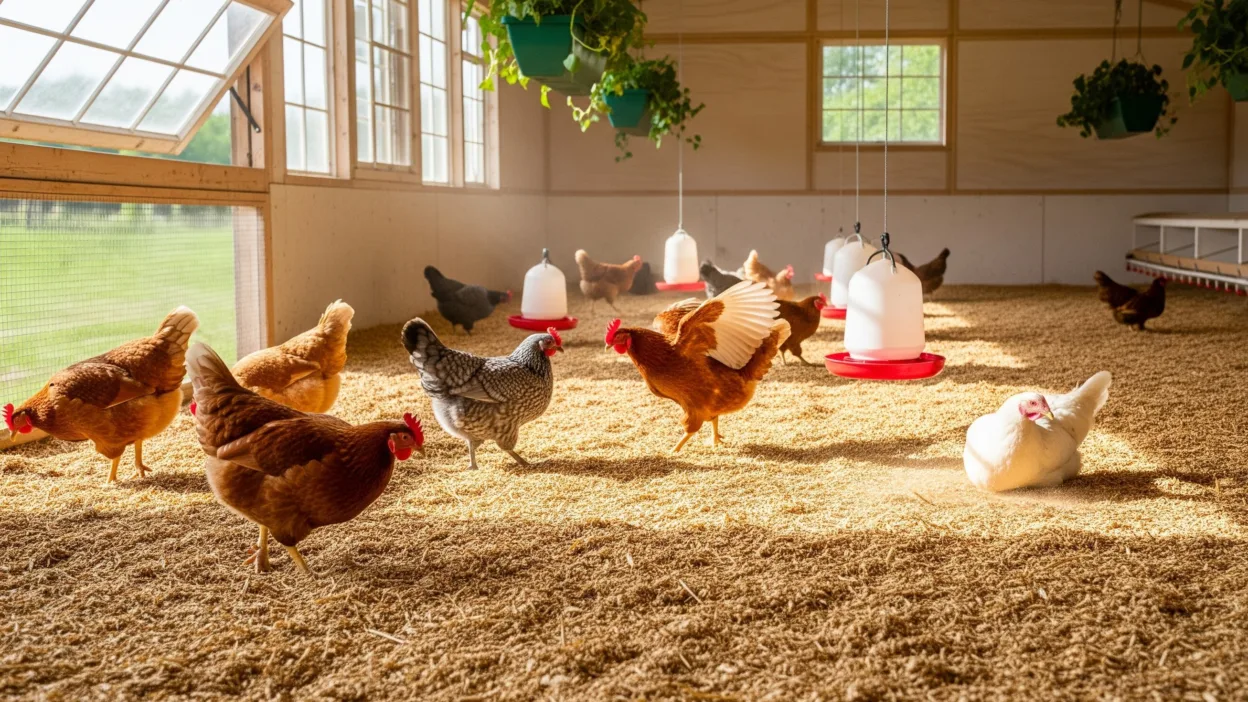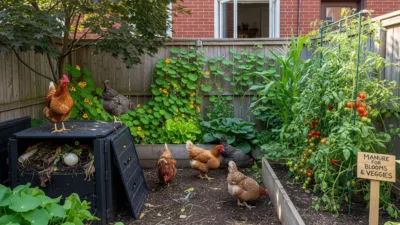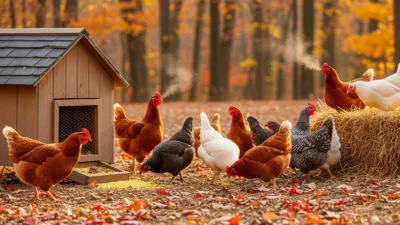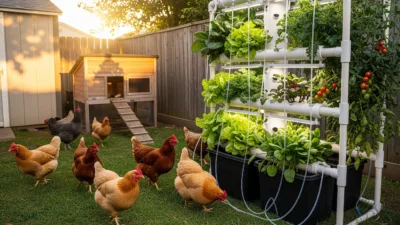Keeping a chicken coop clean and odor-free can feel like a never-ending chore, especially for small homesteads or backyard flock owners. The deep litter method has become a favorite strategy for many chicken keepers because it not only reduces cleaning time but also creates a healthier environment for your flock while producing rich compost for your garden. Best of all, it is a low-cost, DIY solution that anyone can implement.
In this guide, we’ll break down what the deep litter method is, how to set it up, and why it’s an excellent choice for year-round chicken care.
What Is the Deep Litter Method?
The deep litter method is a way of managing chicken bedding inside the coop by allowing layers of bedding and chicken manure to build up over time. Instead of cleaning the coop weekly, you add fresh bedding on top as needed. Over time, natural composting takes place inside the coop floor, breaking down waste and bedding into healthy, soil-like material.
This system not only reduces coop odor but also helps with warmth in winter and creates compost that can later be used in the garden. Think of it as turning your chicken coop into a mini composting system.
Why Choose the Deep Litter Method?
Backyard flock owners in the USA, particularly in colder climates, often rely on the deep litter method because it offers several unique benefits.
1. Saves Time and Effort
Instead of cleaning the coop every week, you only need to do a full clean-out once or twice a year. This is a big time saver for busy homesteaders.
2. Provides Natural Warmth in Winter
As the bedding and manure compost, they generate a small amount of heat, which helps keep chickens comfortable during cold months.
3. Reduces Odor
When managed properly, the deep litter method keeps ammonia smells under control because beneficial microbes balance the waste.
4. Produces Free Garden Fertilizer
After several months, the bedding can be composted into nutrient-rich material perfect for vegetable gardens, flower beds, or fruit trees.
5. Supports Flock Health
The healthy microbes in deep litter may help build your chickens’ immune systems and reduce harmful pathogens.
Choosing the Right Coop Setup for Deep Litter
Not every chicken coop is ideal for this method. Here’s what you need to consider:
- Floor Type: A dirt or concrete floor works best. Wooden floors can absorb moisture and rot over time. If you only have wood, line it with a protective barrier.
- Ventilation: Proper airflow is critical. A well-ventilated coop keeps the bedding dry and prevents ammonia buildup.
- Space: Chickens need enough room to scratch and mix the bedding naturally. Crowded coops will lead to moisture and odor problems.
Best Bedding Materials for the Deep Litter Method
Choosing the right bedding is key to success. The goal is to use carbon-rich, absorbent materials that balance the nitrogen in chicken manure.
Here are the best options:
- Pine Shavings – Most popular choice, absorbent and smells fresh.
- Chopped Straw – Affordable and easy to source but may mat if not mixed regularly.
- Dried Leaves – A free, eco-friendly option in the fall.
- Wood Chips – Long-lasting and excellent for airflow in the litter.
- Shredded Paper/Cardboard – Works in a pinch but breaks down quickly.
Avoid cedar shavings, as the oils can harm chickens’ respiratory systems.
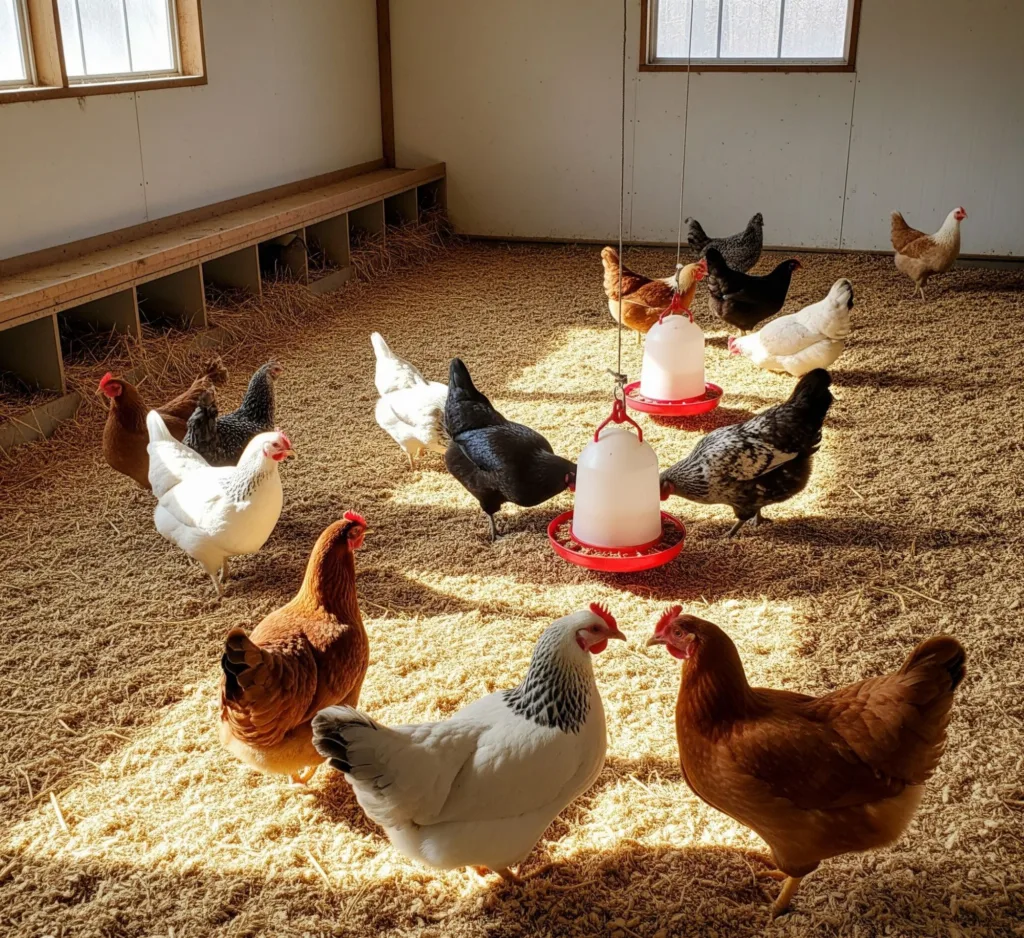
Step-by-Step Guide to Setting Up DIY Deep Litter
Ready to set up your deep litter system? Here’s a simple guide:
Step 1: Start with a Clean Coop
Do a thorough clean-out before beginning. This gives you a fresh foundation.
Step 2: Add a Thick Layer of Bedding
Spread 4–6 inches of your chosen bedding on the coop floor. For colder climates, you can even start with 8 inches.
Step 3: Let Chickens Help Mix
Chickens naturally scratch and turn bedding as they forage. This helps mix in their manure with the bedding.
Step 4: Add Fresh Bedding Regularly
Each time manure starts to build up or smell becomes noticeable, sprinkle on a new layer of bedding, about once every 1–2 weeks.
Step 5: Maintain Ventilation
Check coop airflow. If the bedding feels damp or ammonia smell appears, you may need to adjust ventilation or add more bedding.
Step 6: Turn Bedding Occasionally
While chickens do most of the work, using a rake or pitchfork to turn bedding once in a while helps maintain balance.
Step 7: Seasonal Clean-Out
Do a full clean-out once or twice a year. The spring and fall are great times, since the material can go straight into your compost pile or garden beds.
Troubleshooting Common Deep Litter Problems
Even though the deep litter method is simple, beginners sometimes run into issues. Here’s how to fix them:
- Bad Smell: Add more carbon-rich bedding and check ventilation.
- Too Wet: Improve airflow and use a rake to stir bedding.
- Flies: Usually a sign of excess moisture. Add dry bedding and turn more often.
- Mold Growth: Mix regularly and avoid straw that mats down.
When balanced, the deep litter system should smell earthy and fresh, not foul.
Composting the Finished Litter
After months of use, the deep litter bedding will have broken down into dark, crumbly compost. But chicken manure is high in nitrogen and considered “hot,” which means it should not be applied directly to plants.
Here’s how to finish it safely:
- Move the used bedding to a compost bin or pile.
- Add brown materials like leaves, wood chips, or shredded cardboard.
- Turn the pile every 2–3 weeks.
- After 3–6 months, the compost will be garden-ready.
This compost is rich in nutrients like nitrogen, phosphorus, and potassium, making it excellent for vegetables, flowers, and fruit trees.
Is the Deep Litter Method Safe for Chickens?
Yes, when done correctly, the deep litter method is safe and beneficial. It creates a natural, microbe-rich environment that helps strengthen chickens’ immune systems. However, you must manage it carefully, neglecting ventilation or failing to add bedding can lead to ammonia buildup, which is harmful.
For chicken keepers in northern states, the added warmth is a huge bonus in winter. For southern states, you’ll need to focus more on airflow and moisture management.
Final Thoughts: Deep Litter Method for Happy, Healthy Flocks
The DIY deep litter method is one of the best solutions for backyard chicken keepers who want to save time, improve coop health, and recycle waste into garden gold. With proper bedding, ventilation, and routine management, you’ll enjoy a cleaner coop, healthier chickens, and nutrient-rich compost.
Whether you’re raising chickens in a small rental backyard or running a full homestead, this method fits perfectly into sustainable living. Start your deep litter system today, and turn coop cleaning into a once a year task instead of a weekly chore.
